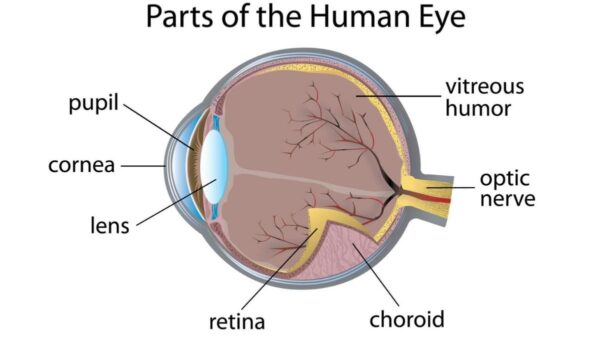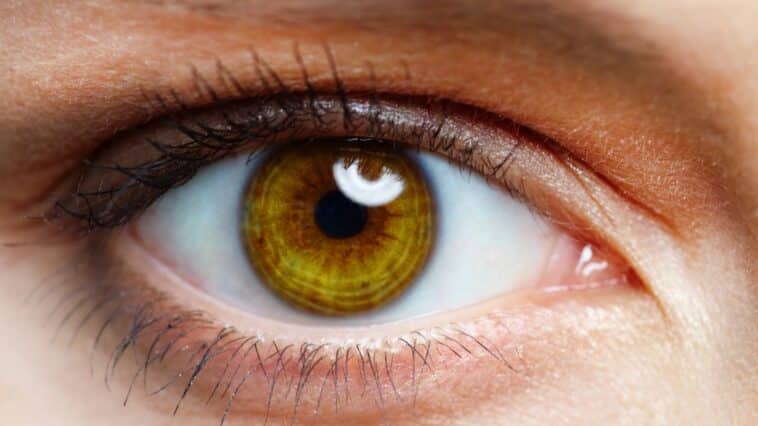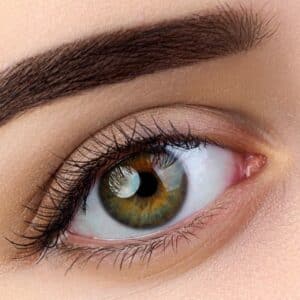What Is the Vitreous Humor?
Vitreous humor is a clear, usually jelly-like substance that fills the space between the lens and the retina of the eye. It gives structure and shape to the eyeball and helps to maintain the intraocular pressure necessary for optimal vision.
Vitreous humor also helps transmit light from the cornea to the back of the eye, which can be converted into signals sent to the brain and interpreted as vision.
Vitreous humor composition consists mostly of water but includes collagen fibers, hyaluronic acid, and other molecules. This gel-like structure does not regenerate or change over time, so there remains a constant amount in each person’s eye throughout their lifetime.
The vitreous attaches to several areas of the eye, including the optic nerve disc at the back of the eye and blood vessels in the retina, and continues attachment to the lens capsule. It is essential for normal vision.

Structure of the Vitreous Humor
The vitreous humor comprises water, collagen fibers, and other molecules. The majority of the vitreous humor is composed of a substance called hyaluronic acid, which gives the gel its viscous consistency. Other molecules found in the vitreous humor include:
- Proteins: This help maintains the vitreous humor’s structure and supports the retina.
- Electrolytes are ions that help maintain the body’s balance of fluids.
- Vitamins: The vitreous humor contains small amounts of vitamins A and E, which may help to protect the eye from oxidative stress.
- Enzymes are proteins that help break down other molecules in the body.
- Hormones: The vitreous humor contains small amounts of hormones, such as melatonin, which may regulate sleep and the body’s internal clock.
Vitreous humor is a complex mixture of molecules that work together to maintain the health and function of the eye.

Disorders Associated with the Vitreous Humor
Several disorders can affect vitreous humor, including:
- Vitreous detachment occurs when the vitreous humor, a clear gel-like substance that fills the eye, begins to separate from the retinal wall. It is quite a common process that happens in people as they age and usually does not cause any major issues. However, if left untreated, vitreous detachment can lead to retinal detachment, resulting in vision loss.
- Vitreous hemorrhage is a condition characterized by blood entering the vitreous humor, the fluid that fills the eye cavity. This can cause the normally clear fluid to become cloudy and opaque. Common causes of vitreous hemorrhage include diabetes, trauma or injury, and bleeding disorders.
- Vitreous floaters: are often harmless, yet they are easily spotted against a bright background. They appear to be small shadowy shapes that float in the eye’s vitreous humor. Although usually not serious, floaters may be signs of retinal detachment and should be checked by an eye specialist as soon as possible if they are suddenly more frequent or intense.
- Vitreous opacities are patches of cloudiness that occur within the vitreous humor, the transparent jelly-like material found in the posterior part of the eye. These can cause vision loss and are caused by many factors, such as inflammation, trauma, and progressive deterioration of the eye.
Disorders of vitreous humor can range in severity, but prompt diagnosis and treatment can help to prevent serious complications.
Diagnosing Disorders in the Vitreous Humor
Disorders of vitreous humor can be diagnosed through a comprehensive eye examination, which may include the following tests:
Visual acuity test: The test is mainly focused on measuring someone’s ability to distinguish fine details from a distance, although other tests such as color vision testing, depth perception examinations, and peripheral vision examinations are also sometimes included in a visual acuity testing session.
Slit-lamp examination: an ophthalmologic exam that allows an eye care professional to examine the anterior and posterior segments of the eye with a magnified view.
It uses a slit lamp, a microscope with limited light sources, and high-magnification lenses. This examination helps to evaluate the health of the eyelid, cornea, iris, lens, optic nerve, and other structures within the eye.
Dilated eye exam: During this procedure, special dilating eyedrops are used to widen the pupils and allow a better view inside the eyes. This eye exam is often used to assess for issues such as glaucoma or other conditions that can only be detected within the eye’s interior.
Retinal examination: is a visual test that involves the use of an ophthalmoscope to take a look at the retina, which is located at the back of the eye. This procedure helps doctors detect any potential problems or irregularities in the eye, such as cataracts or glaucoma, that may be causing vision problems.
Ultrasound: Ultrasound is a powerful diagnostic tool used to create an image of the eye’s inner structures. This imaging technique uses sound waves to detect abnormalities in the vitreous humor, helping to diagnose various eye disorders.
Overall, a comprehensive eye examination is the most effective way to diagnose disorders of vitreous humor and other eye conditions.
Treatment of Disorders of The Vitreous Humor
The treatment of disorders of vitreous humor will depend on the specific condition and its severity. Some common treatments for disorders of vitreous humor include:
Vitreous detachment: Vitreous detachment is a common eye condition that often resolves independently without requiring treatment. However, if it creates uncomfortable symptoms such as floaters or flashes of light, your eye doctor may suggest a vitrectomy. This is a surgical procedure in which the vitreous humor is removed and replaced with a sterile fluid.
Vitreous hemorrhage: Depending on the cause, treatment of vitreous hemorrhage may not be necessary if the blood reabsorbs itself. In certain cases where an underlying cause, such as diabetes or a bleeding disorder, is present, treatment may be needed to address the root issue.
Vitreous floaters: The treatment for vitreous floaters largely depends upon the degree of discomfort or visual impact that they cause. Common treatments include laser therapy, vitrectomy, and intraocular injections. Depending upon the severity of the condition, some individuals may require no intervention at all as the floaters may reduce in time.
Vitreous opacities: Treatment for vitreous opacities depends on the type, size, and location of the opacity. In some cases, surgery may be needed to remove any scar tissue that is associated with the condition.
For small or mild opacities, their symptoms can often be managed with medications such as diuretics and topical steroids. Additionally, laser surgery may be used to block blocked blood vessels from causing further damage to the vitreous gel or retina.






